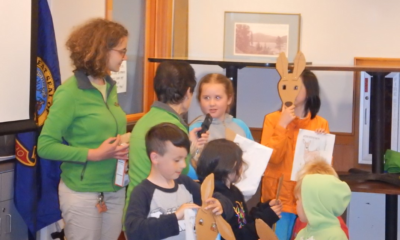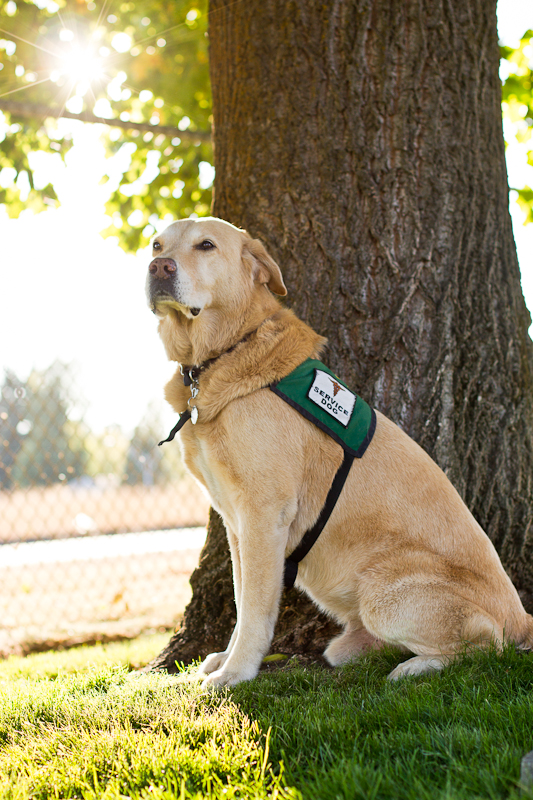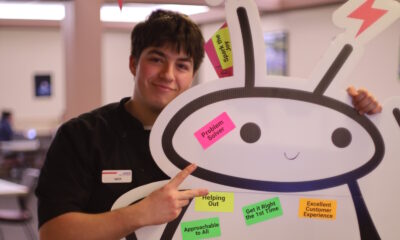Features
Medical dog trainer explains service to society
“I spent a year working with disabilities in the worst cases. With the worst of the worse. I walked next to a man, he’d been in three wars, vomiting in the middle of the mall because he was so afraid to be around people. His dog, Ollie, who had one eye, drug him to the bathroom. That’s what a service dog does.”
Chaun Stevenson Gause trains the dogs that pull veterans suffering from PTSD to the bathroom. She trains the dogs that take off a teenager’s socks because he has been paralyzed from the neck down. She teaches animals to listen, with all their senses, to those who suffer from disabilities. While she currently trains diabetes alert dogs for those who suffer from Type One Diabetes, Gause has been involved in all aspects of the service-animal field for the last several years of her life.
Last year, the federal government announced that men and women suffering from PTSD would have access to federally-funded service dogs. According to Gause, the degree of disability caused by those suffering from PTSD has called for the disorder to be considered a disability in the realms of service animals. Dogs trained to aid those suffering from PTSD are true embodiments of the service, as well.
“[PTSD sufferers] can get lost, get disoriented. They can panic. We qualify these dogs as service dogs because they provide a very important service. It’s not a feel-good dog, not a companion dog, not a therapy dog. It’s a service dog,” Gause said. “And a service dog has free right. Any place where the public is welcome, a service dog must be also be allowed in. [A person’s] ability to function in society depends on that dog, based on safety and health. That dog, that could save his life, is considered a service dog.”
Gause is passionate about society’s education regarding the rights and use of service animals. She has been denied access to restaurants and events multiple times while training service animals. For those who rely on a service dog to guard their life, this sort of discrimination, Gause said, is baseless.
“It’s intolerable, but you can’t get mad at them because they haven’t been where I’ve been and seen what I’ve seen.”
The scope of a dog’s service extends to more than just opening doors.
“What that dog does for that person emotionally is bigger. If you live in a wheelchair and your only sense of independence is given because you have a dog, we don’t see what that dog does at home emotionally and physically. We don’t see that dog put clothes in the laundry. We don’t see that dog pick up the remote control or cell phone or bring you your keys. We don’t see emotion gratification that that person, who has lived alone in their house because they’re afraid to get out, gets from the dog. And courage to get out. Maybe guy wouldn’t have courage to go to school if he didn’t have dog. Maybe that’s not the sort of thing that’s visual. Society needs to recognize that and stop thinking that dogs are just dogs,” Gause said.
Gause stresses the important differences between companion animals, therapy dogs, and service dogs. During her time as a service animal trainer, Gause has seen the line between the roles of these animals blurred.
“I have a problem with Mrs. Jones who brings her little poodle into a restaurant in her purse and calls it a service dog. It’s a companion dog, or even a therapy dog, but not a service animal,” Gause said. “ We need to start clarifying, defining the differences, and respecting the differences of a service dog, because it is given highest level of respect in society. It would be like calling a lifeguard a Navy SEAL. That would be dishonoring what the Navy SEAL has to go through to get that title.”
“Mrs. Jones, who has a dog because the doctor prescribed one for depression, needs to stop pushing the ticket, because she’s not honoring what service dogs are trained for,” Gause said.
Gause describes the training process of true service dogs as rigorous. At sixteen weeks, puppies know 30 commands. At the end of their two-year training, the dog will understand how to perform over 100 different services and tasks. Service animals must also be taught to respect and honor social politeness and codes of conduct. A service dog can’t run off and chase cats, Gause said. The service dog can’t bark or threaten people in society.
“It would not be right for me to train a diabetic alert dog and not train him as a service dog in society,” Gause said. “That dog will be with that person around the clock and should meet all levels of social manners.”
Service dogs aren’t trained on a person-to-person basis, though, except for diabetic alert dogs. At any time, a facility might have 18 to 25 dogs ready to be paired with an owner. Gause has seen matches of a multitude of service animals, from PTSD companions to animals specializing in the ultimate patient, a quadriplegic.
“We watch the relationship. We watch the interaction. The dog responds to them and they’re responsive to the dog,” Gause said. “It’s like a shoe store. You have many shoes and you see what fits you, what you walk in comfortably, what feels good, the size, the color you like.”
Sometimes, the dog-to-human pair blossoms into a unique and highly-personal relationship. One of her service dogs, Chrissy, was sent to a teen in Spokane who was paralyzed from the next down during childhood. After a several months of service to the teen, Chrissy alerted caregivers that her ward was slipping into a coma several minutes before it happened.
“That’s something you can’t train,” Gause said.
Gause is currently training a shelter dog to respond to the needs of a diabetic patient.
“The dog that I have now, they found him roaming with a bark collar and rope around his neck- Now he’s going to become one of the most fantastic diabetic alert dogs.”
“We already have an issue with people who think dogs are dogs–stick them in the backyard,” Gause said. “I think people need to really understand the time that went into training that dog–we’re talking about two years of training–and not be so ignorant to think ‘it’s just a dog.’ I don’t care if he sheds all day long. Because when you weigh this, that dog is so much more.”

















